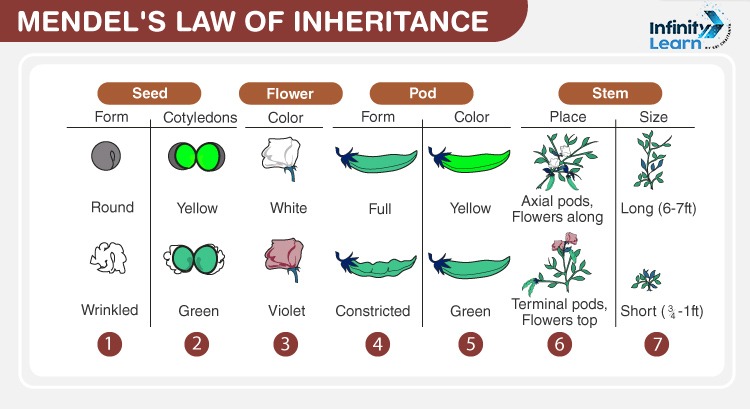Table of Contents
Inheritance is defined as the process by which genetic information is passed on from a parent to its offspring. Due to inheritance, offspring receive characters similar to their parents. The inherited traits are encoded in DNA and is responsible for variations between individuals. In the middle of the 19th century, people started understanding inheritance in a better way. Gregor Mendel developed what is known as Mendel’s rules of inheritance to help people understand inheritance. Thus, this made understanding inheritance easy and simple.

What is Mendel’s Law of Inheritance?
Mendel, known as the “Father of Genetics,” used pea plants to understand how traits are passed down from parents to their children. Between the years 1856-1863, Mendel conducted a hybridization experiment. The experiment was conducted between the garden peas, where different characters of the peas were taken and cross-pollinated. The pea lines showed a stable trait of inheritance.
Why Was The Pea Plant Selected For The Experiment?
The pea plant was selected by Gregor Mendel for various reasons. Below mentioned are the reasons for selecting the pea plant for the experiment.
Different traits
Pea plants have very different and distinctive traits in them. They have very observable characteristics like – color, size, and height. This helped in easily tracking down the traits that passed from one generation to the next.
Control in Pollination
Pea plants have the characteristic of pollinating within themselves. So, they can pollinate themselves. Also, they can be self-pollinated manually. Therefore, it became easy for Mendel to control which plants were crossed.
Less time for generation
The pea plants take very little time to grow and reproduce. So, Mendel could observe different generations in a short period. This helped in tracking down of traits from one generation to another in a short time period.
Large number of offspring production
Pea plants produce several offspring in a very short period of time upon pollination. This helped Mendel gather a large amount of data, which helped him identify consistent patterns and how traits were inherited.
Homozygous varieties
The presence of several homozygous or purebred varieties of peas led to Mendel’s experiment on the pea plants. These features made the pea plant ideal for Mendel’s important work in genetics.
What are Mendel’s Experiments?
The experiment of Mendel on peas consisted of two types to determine the law of inheritance. They are monohybrid cross and dihybrid cross. Let us discuss these experiments in detail below.
Monohybrid cross
Mendel’s experiment involved crossing two pea plants with opposing characteristics (one small and one tall).
- He discovered that the first generation of offspring were tall and referred to them as F1 progeny.
- Then he crossed F1 progeny to get both tall and short plants in the 3:1 ratio.
- Mendel also conducted a similar experiment with various opposing features.
- The features included such as green vs yellow peas, round vs wrinkled, and so on.
- In all situations, he observed that the outcomes were consistent.
Dihybrid cross
In this experiment, Mendel experimented between two pea plants of different characteristics.
- He crossed wrinkled green with round-yellow seeds.
- He discovered that all of the first-generation progeny (F1) were round-yellow.
- This meant that the circular form and yellow tint were the most prominent features.
- He then self-pollinated the F1 progeny to produce four distinct traits.
- The outcome of the seeds were round-yellow, round-green, wrinkled-yellow, and wrinkled-green seeds in the ratio 9:3:3:1.
The two experiments resulted in the development of Mendel’s laws, often known as laws of inheritance. Going further, let us discuss the laws of inheritance by Mendel.
Mendel’s Law of Inheritance
Mendel’s experiments resulted in three important inheritance concepts, known as Mendel’s Laws. These three laws of inheritance are discussed below.
Law of Dominance
This is also known as Mendel’s first law of inheritance. The law of dominance states that hybrid offspring will inherit only the dominant trait in the phenotype. The repressed alleles are referred to as recessive traits. Whereas, the dominant alleles are those that show the phenotype.
- In Mendel’s experiments, he crossed plants with different traits, like tall and short.
- The first generation (F1) always showed the dominant trait (tall).
- The recessive trait (short) only appeared in the second generation (F2) when both alleles were recessive.
- The law of dominance also helped to understand how genetic illnesses and features are passed down in families.
Law of independent assortment
The Law of Independent Assortment means that genes for different traits are inherited separately from each other. This means the way one trait is passed on doesn’t affect how another trait will be passed on.
- A plant’s color gene (yellow or green) is inherited separately from its form gene (round or wrinkled).
- When Mendel crossed plants with different traits, he saw that each trait was inherited separately.
- This showed that different genes are passed down independently.
- This law helps explain why offspring can have different combinations of traits from their parents.
Law of segregation
The Law of Segregation states that each individual has two alleles for each trait, one belonging to each parent. These alleles divide during the formation of sperm and egg cells. So, this way each cell has only one allele.
- When fertilization happens, the offspring gets one allele from each parent, making two alleles for each trait.
- Mendel saw this pattern by crossing pea plants with different traits and observing their offspring.
- This is also known as Mendel’s third law of inheritance.
Do Check: Law of Segregation and Law of Dominance
Key Points of Mendel’s Experiment
Mendel’s investigations revealed patterns that explain how features are passed down across generations. Here are the key points to take away from Mendel’s experiments mentioned below.
- Traits are passed down from parents to offspring via “factors” also called genes.
- Each trait is determined by two variables (alleles), one inherited from each parent.
- Some qualities are dominant, which means they suppress the opposite trait (recessive) in the first generation.
- Traits split during the development of eggs and sperm, thus each cell only receives one component for each trait.
- Different qualities are inherited independently, thus having one trait does not mean having another.

FAQs on Mendel’s Law of Inheritance
Who was Gregor Mendel?
Gregor Mendel, a scientist, discovered the fundamental concepts of heredity by experimenting on different traits with pea plants
Why did Mendel use pea plants for his experiments?
Mendel chose pea plants because they had observable characteristics. They can self-pollinate or cross-pollinate. They have a short generation time, making them suitable for studying inheritance
What is a dihybrid cross?
A dihybrid cross is a genetic test. It examines how two different features are passed down together. This demonstrates that these qualities are inherited individually.
Why is the law of segregation referred to as the law of purity of gametes?
The law of segregation is also known as the law of purity of gametes since a gamete carries just one of two alleles, either recessive or dominant.
What are alleles?
Alleles are defined as variants of a gene that influence different features, such as color or seed shape in pea plants.









